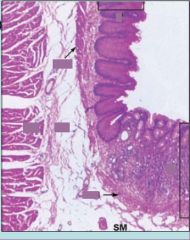![]()
![]()
![]()
Use LEFT and RIGHT arrow keys to navigate between flashcards;
Use UP and DOWN arrow keys to flip the card;
H to show hint;
A reads text to speech;
30 Cards in this Set
- Front
- Back
|
biosynthesis of new glucose from non-carbohydrate precursors, occurs primarily in liver.
|
Gluconegogenesis
|
|
|
gluconeogenesis occurs in the ? and ?
|
liver and kidneys
|
|
|
During fasting, when hepatic glycogen is depleted, ? is essential for maintenance of blood glucose levels.
|
Gluconeogenesis
|
|
|
Energy for gluconeogenesis is provided by metabolism of?
|
Fats released from adipose tissue.
|
|
|
Precursors providing a source of carbon include?,?,? and?
|
Lactate
pyruvate glycerol alanine |
|
|
the major function of gluconeogenesis?
|
produce glucose - achieved by converting low molecular weight compounds such as AA's, glycerol from fat, and lactate.
|
|
|
Gluconeogenesis in general provents hypoglycemia by?
|
increasing blood glucose levels b/t meals.
|
|
|
Gluconeogenesis is essentially the opposite of?
|
anaerobic glycolysis - proceeds by a slightly different pathway, involving both mitochondrial and cytosolic enzymes.
|
|
|
Gluconeogenesis is the only metabolic pathway in the body that uses? and converts it back to glucose.
|
Lactate
|
|
|
Precursors of Gluconeogenesis:
1.)lactate--> 2.)Glycerol from? 3.)AA mainly? |
1.) Pyruvate
2.) from adipose stores 3.) alanine - produced in muscle from other AA's. -Necessary energy for this pathway is being obtained from fatty acid metabolism. |
|
|
converts lactate into pyruvate?
|
lactate dehydrogenase which then enters mitochondria
|
|
|
Converts pyruvate into OAA?
|
Pyruvate Carboxylase - requires ATP and bicarb as substrates.
-Requires biotin as the prosthetic group. |
|
|
OAA formed in mitochondria is converted to either? or ? to enter cytoplasm via malate/aspartate shuttle, then gets converted back to OAA
|
Malate or Aspartate
|
|
|
Cytosolic OAA is then decarboxylated by enzyme? generating?
|
PEPCK
Phosphoenol pyruvate - for the rxn, GTP provides energy |
|
|
After the Formation of ?, glycolysis proceeds backwards until the rxn reaches the next irreversible rxn, PFK-1 in the cytosol
|
PEP
|
|
|
Enzyme that is a major control of gluconeogenesis?
|
Fructose 1,6-biphosphatase.
-Simple hydrolysis of Fructose 1,6-biphosphate.(F1,6BP) |
|

converts F6P to G6P
Fructose 6-phosphate to Glucose 6-phosphate. |

Phosphoglucose Isomerase
|
|
|
converts G6P to glucose?
|
Glucose 6-phosphatase - glucose is released into the blood.
|
|
|
ByPass Enz's of Gluconeo.(4)
|
1.) Pyruvate carboxylase(OAA--> Pyruvate)
2.) PEP kinase 3.) F 1,6 biphosphotase (F1,6 biP to F6P) 4.) Glucose 6-phosphotase (G6P to Glucose) |
|
|
Glucneo makes a ? of glucose/day
|
Kg
|
|
|
Major AA's exported from muscle for gluconeo.(2)
|
Alanine and Glutamine -
Alanine readily gets converted to Pyruvate resulting in the syn of glucose. |
|
|
4 reasons Gluconeo to kick in?
|
Fasting, Prolonged Exercise, high protein diet, and stress
|
|
|
Gluconeo is stimulated when insulin levels are? and glucagon, epinephrine and cortisol levels are ?
|
low
High |
|
|
Production of lactate by muscles and by RBC's, with high protein diet and low CHO diet leads to?
|
Gluconeogenesis
|
|
|
Glycolysis slows during Gluconeo b/c ? is not available to activate Phosphofructokinase.
|
Fructose-1,6-bisphosphate
|
|
|
Gluconeo increases b/c of the decreased concentration of ?
|
Fructose-1,6-bisphosphate - which activates the enzyme fructose-1,6-bisphosphatase.
|
|
|
Phosphofructokinase (Glycolysis) is inhibited by ? and stimulated by ?
|
ATP
AMP |
|
|
Fructose-1,6-bisphosphatase (Gluconeogenesis) is inhibited by?
|
AMP
|
|
|
allows recycling of Lactate to Glucose?
|
Cori Cycle
|
|
|
Facilitates cycling of lactate and glucose b/t tissues and liver?
|
Cori Cycle
|

